Are you a Quiet Speculation member?
If not, now is a perfect time to join up! Our powerful tools, breaking-news analysis, and exclusive Discord channel will make sure you stay up to date and ahead of the curve.
Special Thanks: A lot of the images in this article were found spread out over the internet. Much of the basic information and images come from Apathy House (http://www.apathyhouse.com/fake/), which has done a tremendous job on this subject already. Additional resources came from Wizards of the Coast and the MOTL Trading Forum.
Today's article will focus on fake and counterfeit Magic cards. Many people know about fake Power 9 cards, for a long time the only cards known to be faked (mainly due to the high value and rarity). In fact, I wouldn't consider picking up power or any older cards worth more than $200 without a thorough knowledge on what to look for. But what do we look for?
There are many types of fake cards. Here is a breakdown.
Counterfeit Cards
These cards are printed by other printing companies/printers. There are many possible characteristics to look for when trying to spot counterfeits. The easiest are obvious miscolorations. For example:
The card on the left is the fake, whereas the card on the right is real.
Another print/ink issue to look for is the "dot pattern" on real Magic cards. Real cards have patterns like the ones below (excuse the ? mark next to dot pattern B, the pictures were gathered from a forum and that was in the picture):
Dot patterns on fake cards are usually much less intricate. This is one of the easiest things to look for when checking older cards (though to see the dot patterns properly you'll probably need to pick up a jeweler's loop). It is important to keep in mind that dot patterns will vary from set to set. It is a good idea to have a common that you know is legitimate from the same set when doing side by side comparisons.
Another printer discrepancy that may indicate a fake is a minor difference or variation in the card or artwork itself. Many fakes will display differences in the artwork or text such as in the picture below (the card name text is clearly off).
A more destructive test can be done if you tear a card in half.
Real cards will show that blue line inside the card.
When it comes to Beta cards one of the easiest things to look for are the white "dots" in the corners of the card (seen below).
You can see the little white dots in the corners (especially the bottom corners). Almost all Beta cards will show these dots, the known exceptions are Volcanic Island, COP: Black, and Red Elemental Blast.
A special section of older counterfeits have been dubbed, "Dark Beta" which was done by a former Carta Mundi employee after normal work hours. The cards are very hard to distinguish from actual cards as that employee was using actual Carta Mundi card stock the bend/water/etc test would all pass muster. Apparently they had a bit of an issue with the proper ink and the cards came out slightly off.
"Dark Beta" Moat Real Moat
The light test is another non-destructive way to determine if a card is fake. Magic cards are semi-transparent under a very bright light. The level of transparency is difficult for other printers to match so compare the card(s) in question with a known card (a common from the same set will work fine).
The bend test is a non-destructive test (assuming the card is real) that can be used on cards of all sets. Real Magic cards will recover from being bent (even as harshly as in the picture below). Fakes will not recover and will either stay bent or leave a big crease line. However, even a real card will leave a crease line if you push from the sides (so only bend from the top and bottom edges as seen in the picture). Real cards will fail this test eventually, however most fakes fail it in the first go. If you have a card that doesn't appear to be beat up, then doing the bend test once or twice shouldn't leave any noticeable damage.
The water test is another form of non-destructive test (for real cards). Simply put some water onto a q-tip or paper towel and drip some on the card. Real cards won't be damaged from small amounts of water pooled onto the surface (obviously if you soak them they will start to fall apart...as my friend Kyle can attest to).
The blacklight test is an easy non-destructive way to determine the validity of a Magic card. Real ones will glow under black light as seen below, whereas many fakes will not glow at all.
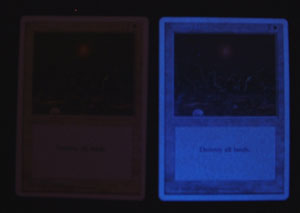 It's important to note that Alternate 4th edition cards will not glow under black light even though they may be legit.
It's important to note that Alternate 4th edition cards will not glow under black light even though they may be legit.
Rebacked Cards
These are cards with real backs and fronts from different Magic cards pasted on. They're usually made using Collector's Edition power, by splitting each card and posting the Collector's Edition front onto a real Magic card back, thus giving the appearance of "real" power. This process tends to thicken the card, as it's quite difficult to split a card exactly in half.
Some rebacked cards are made when the back of the card was considered marked or unplayable, and someone put the front on a new back to allow the card to be "playable" again.
I've only ever heard of this approach being done with power, but as we'll discuss later, the astronomic rise in card prices provides more incentive to fake cards.
For rebacked cards you can usually use the bend test (which will usually cause the two pieces to separate a bit near the crease). Or you can look at the edges (preferably with some sort of optical magnification).
Here we can see a fake edge with a clear "split" in between the two card pieces.
Here is the edge of a real card. As you can see it is one piece. The color of the line may be either black or blue.
New Fakes
Recently a new, much more pressing concern has arisen. Apparently there are printing shops in China which have no qualm illegally printing Magic cards (http://www.alibaba.com/product-gs/1532783589/wholesale_Gatherer_Magic_The_Gathering_for.html?s=p is the one that was found by fellow facebookers with relative ease).
It is expected that these cards will fail many of the tests above, however, the fact that this has popped up so recently means that fakes are branching out from just power and other high-end cards to encompass just about anything.
This picture was posted on the MTG Misprints/Oddities Facebook Page. The Tarmogoyf on the top is the fake. The letters are spaced out more and the paintbrush next to the artist's name is obviously a bit different. This Tarmogoyf was purchased online.
This is a huge problem for all of us who buy and sell cards online.
First, smart buyers will ignore cards without crisp, clear photos. Thus if you don't have a high-end camera (many of us use our phones), you'll risk reaching a smaller population who wants to buy from you.
Even more concerning is when you trade for cards in person you'll have to look much more carefully at the cards, especially the highly desirable, more valuable ones.
This is the type of issue that can potentially kill card values. Were some unscrupulous people to purchase a large quantity of fake cards and then trade or sell them for profits, it could absolutely devastate the secondary market. If people are afraid to buy and trade cards lest they receive a fake, card values (both real and fake) will plummet.
The sellers in China have been offering a 55-card pack of the following cards, with presumably one of each in a pack. Nobody knows if these complete packs made it over, but Jaces, Domri Rade and Tarmogoyf have all been spotted. Be very careful when trading for the following cards on this list:
Tropical Island
Temple Garden
Stomping Ground
Overgrown Tomb
Scared Foundry
Breeding Pool
Misty Rainforst
Celestial Colonnade
Flooded Strand
Arid Mesa
Wasteland
Inkmoth Nexus
Elspeth Sun's Champion
Tarmogoyf
Cavern of Souls
Scalding Tarn
Hallowed Fountain
Polluted Delta
Surgical Extraction
Sol Ring
Underground sea
Maesh Flats
Reflecting Pool
Mutavault
Wooded Foothills
Windswept Health
Watery Grave
Godless Shrine
Nykthos, Shrine to Nyx
Savannah
Blood Crypt
Verdant Catacombs
Kalonian Hydra
Avacyn, Angel of Hope
Thassa, God of the sea,
Jace, Architect of Thought
Swords to Plowshares
Chalice of the Void
Goblin guide
it that betrays
sword of war and peace
sword of fire and ice
purphoros god of the forge
sun titan
sensei's divining top
demonic tutor
elspeth knight-errant
thoughtseize
pernicious deed
sword of feast and famine
goblin lackey
goblin pilcdriver
inquistion of kozilek
engineered explosives
kokusho the evening star
bonfire of the damned
ral zarek
stoneforge mystic
lona shield of emeria
spellskite
karn liberated
tundra
path to exile
figure of destiny
Ather Vial
Vampiric Tutor
Snapcaster Mage
Academy Ruins
Batterskull
Forcc of Will
Leyline of Sanctity
Intuition
Sphinx's Revelation
Reanimate
New...er News!
Apparently there is another fake printer group out there. This one is focused on foils. They are printing high dollar fake foils for the "pimp" groups (EDH/Legacy/etc). From what I've been hearing it was originally started as a kickstarter business printing foil playmats (which I must admit would be pretty cool). Sadly they didn't reach their kickstarter goal (or anywhere near it). Someone bought some foil dark rituals off ebay and took some higher res pictures of them when they noticed something was off (the picture below shows the fake on the left and a real one on the right). The fakes don't "pop" out as much and look slightly grainer. They are also missing some of the "bubbles" in the frame.
Unfortunately, the fakes do have a dot pattern that looks close to correct, so just using a jewelers loop won't protect you.
Luckily, it appears that all of the foils look a bit off so far so keeping a watchful eye and being weary of ebay prices that seem to good to be true are the first line of defense. The second will come when trading, when something looks a bit off you should immediately start to focus more and look for other issues.
The current list of known fakes includes;
- Foil Onslaught Fetches
- Foil Dark Ritual
- Foil Wrath of God (7th ed)
- Foil Glorious Anthem(7th ed)
- Foil Lord of Atlantis (7th ed)
The Good News
The good news is that the human brain is very good at spotting patterns, and (just as importantly) changes in a pattern. If you actually pay attention to the cards you're trading for, your brain will often subconsciously find things "off" on many fakes. I've run across a few during trades and they tended to stand out because I was aware that fakes existed.


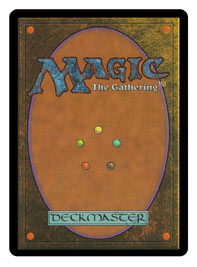
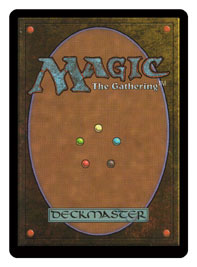
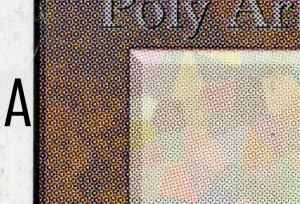
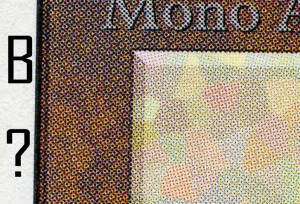
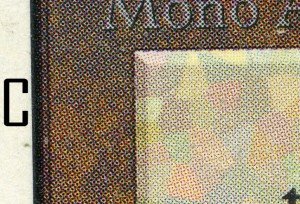
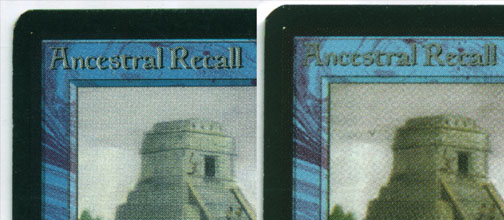
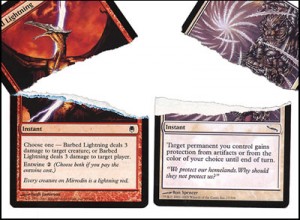
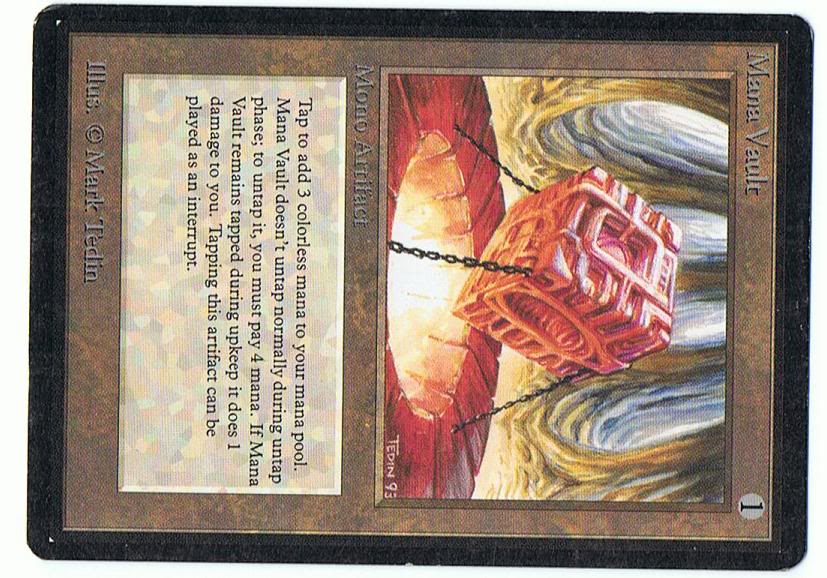
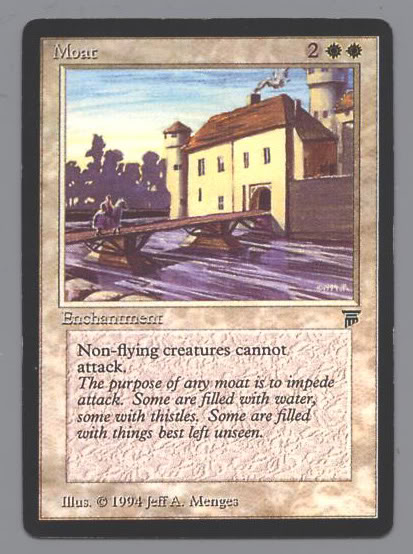
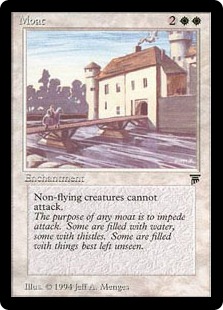
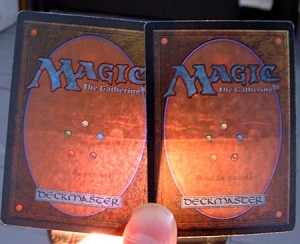
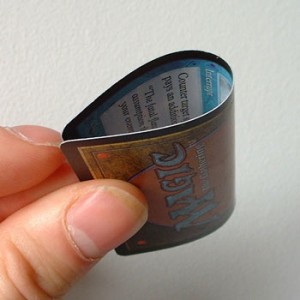
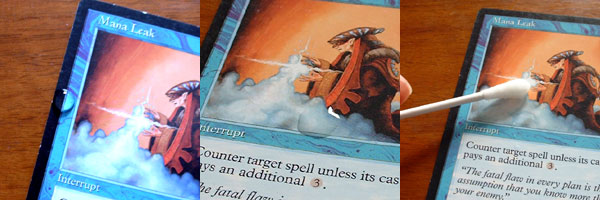
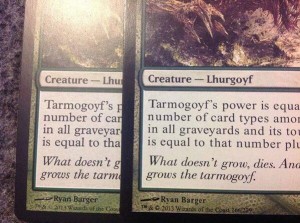
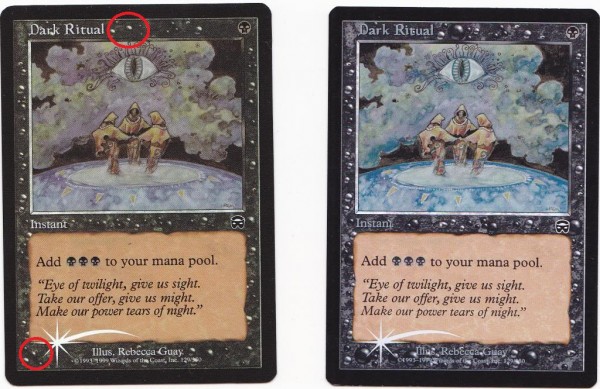
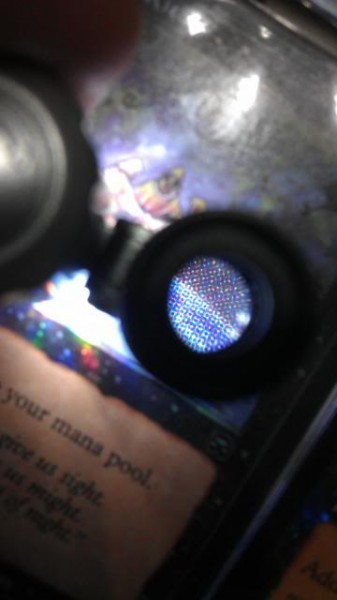
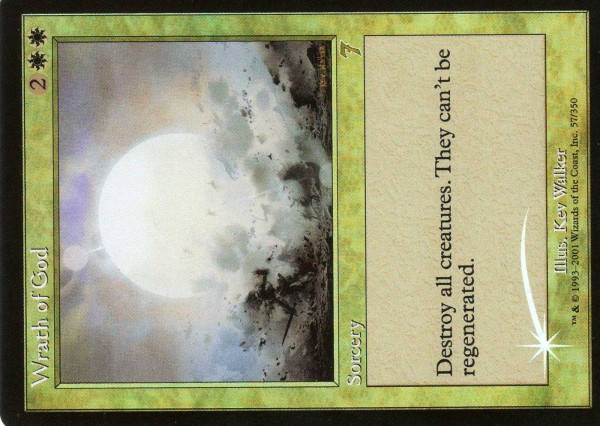


An excellent and timely article! It is quite concerning that counterfeit cards are becoming more of an issue (branching out into “non-power” territory as you mentioned). Someone was attempting to sell fake power 9 on craigslist locally about a month ago. A keen eyed player in the community was considerate enough to post an ad warning everyone about the fakes. Absolutely something to be aware of and on the lookout for while trading or buying. I am curious how the community will adapt to this while trading? People may get offended if their cards are scrutinized more closely with every trade.
Thanks you for the excellent article and all of the tips for spotting fakes!
(PS- Don’t be afraid to bend test a card. Practice on commons, ask permission first, follow the instructions above, then commit. A real card does recover, just ask my Underground Seas).
I agree James. After submitting the article I’ve posted several things in the forum post regarding this issue and I truly believe this is a much bigger concern than many think. I understand that because the copies are “illegal” and WoTC has the right and will press legal actions against the printers some people think this is more of a minor “blip” on the radar. The playerbase itself will need to adapt to this information. We will need to take a hardline against playing with the fakes, I will feel really bad the first time I play against someone and call them out for using fakes (especially given they are unlikely to be aware of them), however, without this kind of hardline stance the use of fakes will be considered a much more “economical” way to play MTG and without strict punishment there won’t be the incentive needed to make players actively root out fakes. After all, if you think about the average FNM player, they would be thrilled to buy their playset of Domri Rade’s for 20 bucks on ebay and take them to their LGS and play with them (likely never knowing they are fake)…then they tire of the deck and trade them off…now those Domri’s are floating through the MTG community likely being traded at “full value” to other un-suspecting players up until they come across someone aware of the potential who looks and validates the cards. Then those with the Domri’s are left feeling terrible that the cards they traded for are fakes and worth nothing and aren’t allowable in tournaments. They’ll be left with 4 options; destroy the cards (what they should do), pull the cards from their decks and trade binders and just put them in a box or something, trade them to people alerting them that they are fakes and are at best “proxies”, trade them to people without saying a thing….sadly I see option 4 being used the most because nobody wants to get stuck with the loss. The only way to properly combat this is to get the playerbase aware of the issues and to isolate fakes as soon as possible. If unethical people are bringing in fakes to unload and find that they can’t do so they will stop doing it.
I am not sure there is much that Wizard’s can really do. Suing internationally (especially China) is very difficult if the foreign government does not care. Fake pins (aka scrappers) have plagued the Disney pin collecting hobby for years. Little is done about it.
Yeah I don’t see much being done on that level. Hell, look at the miniature wargaming hobby. There have been counterfeit minis being made in China for years, and as much as Games Workshop goes about suing like maniacs they can’t do anything to stop the Chinese Warhammer/40k knock-offs.
It’s nice to know people read that post. When i put it up I assumed most people were going to ignore it 🙁
First, why the question mark next to dot patern B?
I much appreciate this article. One place to gather information on counterfeits is a very good idea. That said I think this should both be a free article and updated as some of the information presented is incomplete or even incorrect.
– I would add a reminder to bring a common from the same set for the dot patern check.
– Real cards will show either a blue or a black trace of the glue, not just the blue. Under magnification you might identify the line along the edge as well.
– Not all Beta cards have the white dots. A 3rd copy of every Basic land type was added, the darker one compared to the other 2 and these do not have the white dots. The same is true for Volcanic Island and CoP: Black, which also wern’t in Alpha. For some reason Red Elemental Blasts also don’t have dots as I noted when searching for my CoP: Black and there might be others too.
– Real cards will fail the bend test eventually. High end cards may have been frequently bend tested already and doing so again may lead to damaging them. I would recommend against this practice unless you are already in doubt. Definitely execute every other test before trying this one.
– Alternate 4th cards also don’t glow in black light. They could be argued to be fake, but should probably be noted seperately.
– A link to some of your sources could be recommended, http://www.wizards.com/magic/magazine/Article.asp… and http://www.apathyhouse.com/fake/ both have some info in addition to what’s in your article.
It would be great if your article had also covered “Dark Beta”, which was an after hours printing on the actual printers with the actual card stock done by a former Carta Mundi employee. Except for being darker than normal cards “Dark Beta” cards are indistinguishable from real cards. Despite the name one can also find non-Beta cards from this printing, I have for example seen a Moat come by on the rarities and misprints FB group.
Having been sold a Fake Beta Sapphire gets you rather interested in how to spot fakes in the future…
Hasbro also has shown precedent for completely ignoring Chinese counterfeiting operations in the past. So far, they have completely ignored counterfeit G1 Transformers for about 6 years, for example.
I think that this article should be on the free side, it is very important the all the magic comunity know about this.
Great article!!!
Thanks Pi. I will actually dig deeper into the subjects you’ve broached here and amend the article as such. Ideally I’d love this to be a VERY comprehensive article covering everything we can think of. Unfortunately, I was only made aware of the counterfeit Tarmogoyfs (and other non-power) counterfeits Sunday night/Monday…and I submitted my article Monday night (thus time constraints prevented me from going as in depth as I’d like)..hence consider this article a “living document” (to borrow a favorite term of some co-workers).
(Yet one of your pictures has a fake Razor Barrier ;)).
I’d also try to get the article on the free side. There is no reason for this to be insider, in fact, it might shine a negative light on QS if information on how to identify fakes is not shared with the general public.
Making it a living document seems like a good idea. If you want me to proofread some of the information you gathered feel free to send me a PM. I wouldn’t say I’m an authority on spotting fakes, however I am a bit of a sponge as far as information gathering on things that interest me goes. If I’ve read anything related I will remember I have.
Great article, although it’s one of those that I strongly feel should be on the free side of the website.
Has any managed to pick up a copy of some of these fakes to do the tests?
Great that you’ve done some updates. I usually go by “pi”, no capitals, maybe you could update that?
Some more comments:
– Your first reference to the blue line is under the picture of the torn up cards. I suggest to place the comment in regard to there also sometimes being a black line, there. It makes less sense in the rebacked section. Maybe an anecdote to add would be that there’s supposedly a Summer Taiga out there that was torn to a small extent to check on its authenticity.
– Good that you have an example of “Dark Beta” in there, I also remember a Tundra being shared on the Misprints and Rarities FB group in case you want to look for more examples.
– You didn’t add whether the light test example shows 2 real cards or a fake and a real one. The right one is a fake. They are probably the same Armageddons as you show later on in the black light test.
– You’ve missed the basics in the list of Beta cards that don’t have dots, also, I am not sure if my list is complete, there may be others. It could be worthwhile to do a check of more cards, I just had a quick look through my commons.
– A bend test leaves no trace on a card right up to the point when it does. You cannot see if a card will survive the bend test. I agree a beat up card is more likely to fail, but there is no guarantee a NM real copy will pass.
I went through Markers’ fully signed set:
http://www.wizards.com/magic/magazine/article.asp…
I identified a few more:
COP: Red
Channel
I have confirmed both with copies I own.
Basalt Monolith seems to be darker, just like the others, but does have small dots on the left side (which are a little red-ish on my copies). Icy Manipulator is also darker, but a white dot is visible in the bottom right.
Interestingly Markers’ copy of Volcanic Island does appear to have dots:
http://media.wizards.com/images/magic/daily/arcan…
But that would mean that either his or this graded copy is a fake:
https://www.abugames.com/images/products/gradedbe…
I’m not sure what to think as I do think Markers knows his stuff, though it’s clear to me that the dots are not a good rule of thumb.
I mentioned Marker’s Volcanic Island in a discussion on the Beta dots on the FB Misprints and Oddities group and this eventually led to a thorough check of Marker’s card. His card unfortunately turned out to be an altered Unlimited copy.
About the light test: how do you figure the right one in the picture is fake?
I’ve tested with several cards and some show a sort of “muddy” shadow (reminiscent of the left card in the picture above), while others look smoother (more similar to the right one). Other than that they let about as much light through. This seems random, but newer cards mostly have the more “muddy” shadow. I figured it’s just an insignificant printing difference. I don’t know if that’s what you’re talking about, can you explain your reasoning?
I wish I could show off my skills here, but I simply went to the page he got the images from and it literally says “The one on the left is real, the one on the right is fake.”.
If you can, compare to a copy of the same card from the same set or otherwise try to get as close as possible (same set, color and card type perhaps). While you might see differences between sets within a set the results should be comparable.
(It was taken from Apathy House’s guide for detecting fakes).
This is a great article. Now checking what a blacklight is.
They are those purple-ish lights you often see in bars or discos that make white clothes light up (anything white really).
If you’re not from the US then its probably called a UV light (I’m from the UK)
Hi
Just wanted to note, that with a jewelers loop (I have 30x with a led light which works nicely) you can also check out the blue line that you can see when ripping the card, without actually destroying it. It’s easier to see it from the corners, but it can also be seen from the sides with a little practice.
I’ve got one of these:
http://dx.com/p/45x-21mm-jewelers-loupe-magnifier-with-white-led-illumination-3-lr1130-48484
At DX’s prices you can’t really go wrong.
o_O That loupe is chinese! 😛
Surprisingly you can still read English card text with it :P.
I bought a fake Mox Pearl off eBay a number of year ago. The seller took it back claiming he didn’t know it was fake. I have my doubts but at least I didn’t get screwed.
Has anyone tried to order that set from the printing company. It would be interesting, for the sake of the community, for someone to buy them and report on the quality and how to tell them apart.
Sucks that the Chinese are the ones behind this. Their government doesn’t care and, in fact, to some extent encourages this type of behavior. They do the same thing in the international market by manipulating their currency. Their culture has no respect for intellectual property. There won’t be a lot Hasbro can do.
They are usually called black lights here in The Netherlands.
So those white dots are supposed to be on Beta cards? I have had a Beta Wheel of Fortune for years that I thought was in worse condition than it is because of those.
Yeah, those are normal, most Beta cards have them. You find them on Alpha cards as well.
Here a chat I just had with the supplier/printer in China
cn220161770(2014-01-09 09:09:33):
hi, what can I do for you?
guest(2014-01-09 06:05:53):
can you tell me more about your magic the gathering cards? What do I get if i order.
cn220161770(2014-01-09 06:07:18):
sorry no stocks now’
guest(2014-01-09 06:07:46):
When will have have more in stock?
cn220161770(2014-01-09 06:09:19):
10days later, don;t tell anybody
\”10days later, don;t tell anybody\”
Come on man, he gave you clear instructions!
I’m very curious as to how the new counterfeits hold up to the dot pattern test and UV test.
I’ll try and buy some in ten days and post what I find plus detailed scans if I can get them to sell me a set. The site seems to imply they are only really cheap at bulk prices. I’m not interested in buying 100s of sets.
They are unlikely to hold up well, and here’s why:
The dot pattern you see is a moire pattern, and is a result of the offset printing press process. There are four different colors of ink that are printed out as a set of halftone dots (a “dot screen”), and each screen is at a different angle. The interference pattern created by the overlaying of these differently angled screens is the moire pattern.
When someone wants to produce a counterfeit card using an offset press, they are not going to have access to the original artwork that Wizards used to print the card, so they are going to have to scan a card. That scan will not have the same amount and quality of image data as the original art scan, and will likely need to be blurred to eliminate the original moire pattern in order to have an image that can be used to create a new halftone screen for the counterfeit. You can see this on the Ancestral Recall in the article. This means that close examination of the card’s art will likely always reveal some telltale differences, even if the rest of the layout gets more sophisticated.
Theoretically, someone could do a very high resolution scan of a card and reverse engineer the CMYK and text K plates of a Magic card, and then print an exact-enough dupe on a printing press, but it would be an awful lot of work and would probably still have some kind of telltale visual flaw or fail to pass another test.
I live in China, have been for the past decade, and honestly, all the fakes we actually see here, are horrid. The really good fakes are sent overseas. Now, I have bought boxes of fake cards, with the intention of using them for cube and edh. Nobody has ever tried to pass of fakes as real and sell them to me.
I just got this email from one of the chinese vendors:
“Dear customer,
I am Sorry, our company was stopped by the police, so we can’t do MTG cards business no!
pls don’t response here to make the e-mail box full.
Thanks
Delson”
So hopefully the gig is up for them, for now, but I highly doubt it will stop them for long.
Just a quick note: Looking for obviously miscolored backs will also turn up every Alternate 4th card you own as a fake. The “A” in the Magic logo on the back of Alternate 4th is darkest in the upper right corner, as opposed to every other card where there’s a light spot in the upper right.
Does anyone have a direct link to this “55 card set” being sold? I would like to do some more research.
ya “some reasearch”…
Just got a fake in the mail today that I bought on Ebay. Glossy coat when you look at it from the side, Flimsy feeling, blurred text, thicker black border, and the side of the card where it is glued together doesn’t match that of a typical card.
We’re currently talking with printers in China about getting some tokens made for our shop. One of the vendors sent me this just yesterday. Apparently the 55-card fake decks are alive and well.
————————————————————–
For the MTG cards , not originl cards. rare cards
US$25 for a deck, 55 cards in a deck,
4 decks at least. US$150 for 4 decks including freight by DHL to USA
please let me know, if you want to buy,
LEO
the list:
1-Arid Mesa
2-Jace the mind sculptor
3-Tropical Island
4-Temple Garden
5-Stomping Ground
6-Overgrown Tomb
7-Scared Foundry
8-Breeding Pool
9-Misty Rainforst
10-Celestial Colonnade
11-Flooded Strand
12-jace architect of thought
13-Wasteland
14-Inkmoth Nexus
15-Elspeth Sun’s Champion
16-Tarmogoyf
17-Scalding Tarn
18-Hallowed Fountain
19-Polluted Delta
20-Sol Ring
21-Underground sea
22-Maesh Flats
23-Reflecting Pool
24-Mutavault
25-Wooded Foothills
26-Windswept Health
27-Watery Grave
28-Godless Shrine
29-Savannah
30-Blood Crypt
31-Verdant Catacombs
32-Swords to Plowshares
33-Chalice of the Void
34-sword of war and peace
35-sword of fire and ice
36-demonic tutor
37-elspeth knight-errant
38-thoughtseize
39-pernicious deed
40-sword of feast and famine
41-goblin lackey
42-goblin pilcdriver
43-engineered explosives
44-lona shild of emeria
45-stoneforge mystic
46-karn liberated
47-tundra
48-Vampiric Tutor
49-Snapcaster Mage
50-Academy Ruins
51-Batterskull
52-Forcc of Will
53-Intuition
54-Sphinx’s Revelation
55-Rcanimatc
Wonderful learn, I simply handed this onto a colleague who was doing some research on that. And he actually purchased me lunch because I discovered it for him smile So let me rephrase that: Thanks for lunch! Anyway, in my language, there should not much good source like this.
Scared Foundry? Yeah, that would stand out as a fake.
Critics of the law call it the ‘Shoot First’ doctrine.There was no confession (although George Zimmerman never denied he was the one who shot Trayvon Martin),”A drug that was legal to possess yesterday, or have become more widely used in recent years.500000. Kc————–Vs.NSO conductor Peter Gardner on? who died of ALS in late January”I haven’t seen that amount of fish or the size of the fish that we encountered this spring in well it’s over 20 years”—Fisheries scientist? but he’s a lot shorter.AAPTopics:,,Scott.
Jonathan Walters (Stoke City) wins a free kick in the defensive half.
The best way I’ve found that’s super simple without ruining the card is look at the back of the card in the blue section of the word “Magic” real cards will have hash lines where the printer hit it. Fake ones will not have these lines.
Just curious, but is it a coincidence that the cards C&A spell MonoPoly?
Hi I have a question. I am currently selling my husband’s Beta collection on my eBay store and I have listed a Beta Forest set. We have noticed that some of the cards do not have the two dots at the bottom and some do and some only have 1 dot, also the color lightness varies on them. My husband bought all of these cards from packs over 20 years ago so he KNOWS they are not fakes. He has never bought beta lands on the open market. I recently had a customer question the cards because of the lack of dots and the brightness of the card. How can I assure people these are legit.